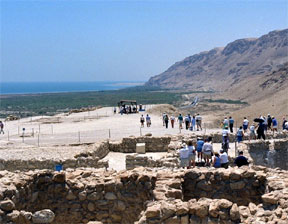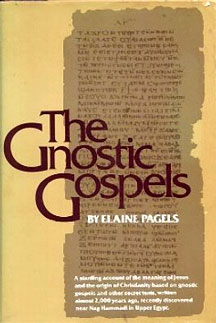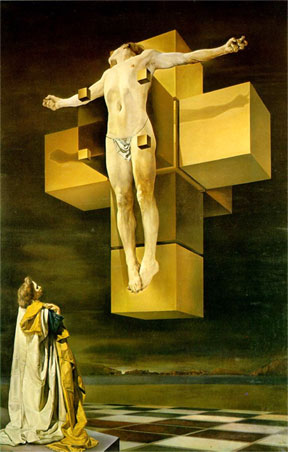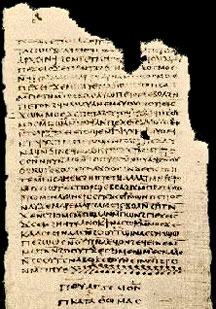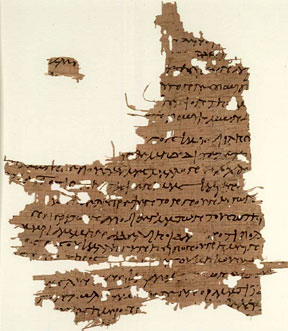Hi. Welcome to the post of
part 10 of the series by
Dr. Mark D. Roberts on
The Da Vinci Code. I hope that what you have read has disabused you of some of the misconceptions about the book and movie, that its assertions of fact that the core principle of Christianity, that Jesus is God, is "so great the con of man," are filled with half-truths, misrepresentations, historical inaccuracies, and outright lies. But just in case, here are some more reasons to make that conclusion.
Yesterday, I printed the article in part 9, of the assertions attributed to Jesus in the non-biblical Gospel of Thomas. Most telling, is that, to support a concept of feminine-based theology, popular to feminists today such as Dan Brown's wife, a Gospel is cited that states a teaching that Jesus would never have supported, that in order for a woman to have the "knowledge" necessary to make eternal life with God, she had to "be made male" by Christ, for only those women who "would become male would enter the kingdom of heaven." Such a notion would be a horror to any modern woman, and it certainly should. That inconsistency in relying on such sexist garbage, whether it be literal or (likely) symbolic, mental or spiritual in achieved "gnosis-knowledge", should be enough to discredit the whole Dan Brown conspiracy tale as a yarn for the dust bin. But, alas, we have to say more to persuade the reluctant to believe the heart of a 2,000 year-old faith.
Here, in parts 10-13, Dr. Roberts deals with Gnosticism itself, which is the fundamental belief system of the manuscripts relied upon by Dan Brown (and his wife), to advocate this entire conspiracy that an alternative to traditional Christianity was created through a physical family of Jesus by marriage to Mary Magdelene, not a spiritual family that we know of today as the Church of Christ. His belief is that, through Leigh Teibing (played by Ian McKellen), Gnostics were the true original Christians, but that they were wiped out and scattered by the orthodox Christians who (in what became the Roman Catholic Church) made an alliance with the Roman emperor Constantine the Great. The true nature of Gnostic belief was made discoverable by the finding of a number of Gnostic manuscripts at Nag Hammadi in Egypt in 1945, published for public view in 1977.
The nature and practice of Gnostics, and their claim of Christian authenticity and being crushed via political intrigue rather than the honest search for Truth, is discredited both theologically
and historically, but I leave it to Dr. Roberts to do the work. See it below, and in its original form, clicking
here and
here.Excursus: What is Gnosticism? 
Part 10 of series:
The Da Vinci Opportunity 
Posted for Friday, March 24, 2006
Throughout this series on The Da Vinci Opportunity I have been speaking of Gnosticism. This is necessary because, though The Da Vinci Code doesn't discuss Gnosticism directly, it does draw from Gnostic writings, and it does speak favorably of the gospels generally known as Gnostic. Before I go further in this series, I want to put up a brief overview of Gnosticism. If you're already familiar with this subject, you can check to see if I've done an adequate job. (If not, please e-mail me with your suggestions.) But if your notion of Gnosticism is rather foggy, let me reveal the truth (Gk. gnosis) about Gnosticism.
Gnosticism is the modern term used to refer to a religious and philosophical movement that originated in the first or second century A.D., that was especially strong in the second and third centuries A.D. and that was considered heretical by the majority of Christians at that time as well as the majority of pagan bearers of the Platonic philosophical traditions (i.e., Neo-Platonists). The ancients often referred to the people of this movement as Gnostics (gnostikoi). The movement, which was not a single, monolithic social-theological reality, emphasized at its core a special claim to special gnosis (gnosis, knowledge); thus the terms Gnostics and Gnosticism. Until the discovery in 1945 of a large group of texts near Nag Hammadi, Egypt, most of our knowledge of the ancient Gnostics came from their opponents. With the Nag Hammadi texts (usually designated NHC, Nag Hammadi Codices [Books]), which were made available to the public between 1956 and 1977 and most of which can be identified as Gnostic writings, we have for the first time in our modern period the opportunity to understand Gnostics on their own terms. (p. 400).
If you're unfamiliar with Gnosticism, I'd urge you to read this definition again. Seriously. It will help you grasp what Gnosticism is really all about.
Since we have very little knowledge of actual Gnostic communities, it's hard to say much about how Gnostic people actually lived. Sociological analysis of Gnostic documents can offer some suggestions, but these are more speculative than solid. Yet the fundamental feature of Gnostic belief, which surely influenced Gnostic practice, is a profound dualism that affirms the goodness of spirit and the badness of matter. The physical world, from the Gnostic point of view, is evil. In fact, it was created not by the one true God, as in Christian belief, but by some junior, wannabe god. This god messed up big time, creating something that shouldn't have been made in the first place, and that needs to be transcended if an individual wants to experience salvation. Because they considered matter, including physical bodies, to be fundamentally evil, it's likely that most Gnostics were also ascetics (denying bodily pleasures). Christian opponents sometimes accused Gnostics of being libertines (engaging excessively in bodily pleasures), and some might have been. But a body-denying ethos pervades most of Gnosticism, and suggests an ascetic denial of human existence.
Although Gnostics believed that matter, including human bodies, was evil, they did not think human beings were without hope. Imbedded within people, or at least some special people, was the spark of the divine, a tiny bit of the real God. Thus salvation involved receiving revealed knowledge (gnosis) of the fact that one had divinity buried within oneself. This knowledge, when believed, allowed a person to transcend the evil world, and ultimately to return to the good God. Whereas orthodox Christianity held that sin (rebellion against God) was the fundamental human problem, Gnostics believed that ignorance was that basic problem. Since matter was basically evil, from the Gnostic point of view, the redeemer was often seen as something other than human. Many Gnostics believed that Jesus the man was not the same as Christ the revealer. Moreover, since salvation required the revelation of knowledge, not atonement for sin, Gnostics had no place for the death of the Savior by crucifixion. In many Gnostic writings the real Christ is not crucified, but stands nearby laughing when Jesus is killed. | |
| The Jewish sectarian community at Qumran along the Dead Sea had ascetic tendencies. World-denying folk often live in desolate places, like Qumran or the Egyptian desert.
|
The Gnostic system makes sense. I'm not saying I believe it, of course. But it has its own internal logic. Yet this logic leads to elitism, because only certain, special people have the knowledge required for salvation. It also leads to a world-denying life. You would not find in Gnosticism a philosophical basis for making a difference in the world. Issues of justice have to do with the evil world that Gnostics must transcend, not transform. Unlike Jews and Christians, Gnostics have no hope of a renewed world, a new creation yet to come. Rather, they hope to escape this world through their special knowledge of their own divinity. Thus Gnosticism is not only world denying, but also individualistic. One does not find in the Gnostic writings a concern for building a community of believers, though there may well have been such communities. I believe that early Gnosticism died out, not only because it was opposed by orthodox Christianity, but also because its vision was simply too individualistic and other-worldly to sustain a thriving religious tradition.
In many ways, however, Gnosticism has been making a comeback. In my next post in this series I want to say something about the popularity of Gnosticism today, which has surely influenced Dan Brown in his writing of The Da Vinci Code.
To continue with Part 11 of The Da Vinci Opportunity, click here.
Excursus: Why is Gnosticism Popular Today? 
Part 11 of series:
The Da Vinci Opportunity 
Posted for Monday, March 27, 2006
| Gnosticism, in its Christian guise, flourished during the second and third centuries A.D. But it soon fell off the radar of significance and was largely ignored by most people, Christian or not, for centuries. This happened, in part because of orthodox Christian opposition to the Gnostics, and in part because of Gnosticism's own internal flaws (see my last post for details). In the language commonly heard today, the Gnostics were the losers in the religious debate. The orthodox Christians were the winners. |
| | FAQ: Why is Gnosticism popular today? | |
Yet the losers have been making quite a comeback in the last few decades. In scholarly tomes and popular paperbacks, Gnosticism takes the spotlight. The Gnostics are often seen, not as the losers in a fair theological debate, but as the victims of orthodox prejudice and power. Gnosticism is the David fighting against the big, horrible Goliath of orthodoxy and the Roman Catholic Church. Many contemporary writers not only defend ancient Gnosticism against its oppressor, but even find personal inspiration from ancient Gnostic writings.
This is a most curious situation. Why would an ancient, esoteric, and sometimes bizarre collection of documents receive such attention today? And why would it inspire many to appreciate if not to adopt Gnostic beliefs? In the rest of this post I'll try to sketch out some reasons for the contemporary resurgence of Gnosticism.
The Attraction of Gnosticism for Scholars
Scholars have been aware of Gnosticism for centuries, largely because many orthodox church fathers (like the second-century bishop, Irenaeus of Lyons) wrote disapprovingly about this amorphous movement in early Christianity. Interest in Gnosticism grew after 1945, when a collection of Gnostic documents was found at Nag Hammadi in Egypt. Yet scholars had to wait for years to have access to the Nag Hammadi tractates. Finally, in the 1970's, the full collection was published for scholars. In 1977, a definitive English translation was published, The Nag Hammadi Library in English. For the first time, people could read for themselves what Gnostic writers actually believed. Then, in 1979, Elaine Pagels published her controversial bestseller, The Gnostic Gospels. This book popularized Gnosticism, not only as an academic curiosity, but also as a compelling version of Christianity for folks who could not stomach Christian orthodoxy. (Note: In The Da Vinci Code Sir Leigh Teabing refers to a book called The Gnostic Gospels, [p. 245] which he takes to be a collection of actual documents. In fact, Pagels's book was a discourse about these documents, not a collection of them.) | |
| The original cover of The Gnostic Gospels. |
As I explained earlier in this series, I found myself in the middle of the Gnostic buzz when I was a student at Harvard. In 1978, during my junior year of college, I took a seminar on "Christians, Jews, and Gnostics" with Prof. George MacRae, who had translated several of the tractates for The Nag Hammadi Library in English and was one of the world's leading scholars on Gnosticism. It was exciting to study texts that had received very little scholarly attention with someone who knew them so well. (Prof. MacRae was a major reason I decided to do a Ph.D. in New Testament. He would have been my dissertation adviser, but he died in the mid-80s, just as I was beginning my research.)
When The Gnostic Gospels came out in 1979, I was studying New Testament at Harvard, the very school from which Elaine Pagels had received her Ph.D. nine years earlier. Many of my colleagues were friends of Pagels and cheered her work. Some, I remember, were envious of her wide popularity. A few even criticized her for being a "popularizer," which cut against the elitist grain of scholarship. The professor who was Pagels's dissertation adviser, Helmut Koester, became my dissertation adviser several years later, after Prof. MacRae died. Many of my fellow students went on to build their academic careers as experts in Gnosticism, notably, Ron Cameron of Wesleyan University. So, during my graduate school days, Gnosticism was in the air.
Part of what was so exciting in those days was the chance to dive into original texts that had never been studied before. Until that point of time, most New Testament scholars and graduate students had to rework the same soil that had been turned up by others for centuries. Now we had an unprecedented academic bonanza. These were heady times, especially for scholars who had lost some of their zeal for studying the New Testament itself. Many of my colleagues at Harvard had once been committed Christians, often of a very conservative stripe. Love for Scripture drew them into the academic study of the New Testament. But, somewhere along the way, they lost their belief that the canonical writings were God's gift to us. Some became liberal Christians, without any conviction of biblical authority; others became agnostics, without any religious faith at all. Anti-conservative bias was encouraged by some, but not all of the faculty at Harvard. I remember one of my professors lecturing on the orthodox notion that one must "stand under" the text in order to "understand" it. "That's bull****!" he said, in a classroom filled with 150 seminarians.
Yet some my colleagues who had given up orthodox Christianity still longed for meaning in their lives. They found hope in the interpretations of Gnosticism by scholars like Elaine Pagels, who saw in the Gnostic writings not only a way to forge a successful academic career, but also an appealing alternative to orthodox Christianity. Gnosticism, especially when run through the interpretive grid of postmodern academia, seemed to support many of the values endorsed by liberal- or post-Christian academics. Gnosticism was envisioned to support feminism, religious pluralism, the supremacy of knowledge, the non-divinity of Christ, the non-literal resurrection, and the self as the source of ultimate meaning. Gnosticism also appealed to the elitism that is rampant in academia.
Excursus: Why is Gnosticism Popular Today? (cont) 
Part 12 of series: The Da Vinci Opportunity 
Posted for Tuesday, March 28, 2006
Yesterday I began to explain why, in my opinion, Gnosticism is popular today, especially among academics. My last point was that when ancient Gnosticism is run through the interpretive grid of postmodern academia, it appears to support many of the values endorsed by liberal- or post-Christian academics: feminism, religious pluralism, the supremacy of knowledge, the non-divinity of Christ, the non-literal resurrection, and the self as the source of ultimate meaning.
Many of these values can be found in the Gnostic writings from Nag Hammadi if you dig around carefully. (The whole Nag Hammadi Library, by the way, includes non-Gnostic documents as well.) But these notions are affirmed only through a selective reading of the evidence. For example, some texts do indeed speak positively of Sophia (a divine female revealer) and do indeed refer to the Holy Spirit in female terms. And in some places women, like Mary Magdalene, are held up as inspired revealers. Yet other texts in the Nag Hammadi Library are about as far from feminism as one can travel. (See, for example, my discussion of Gospel of Thomas 114 in this series .)
| Moreover, scholars who have become enamored with Gnosticism generally do not take Gnosticism on its own terms. They do not, for example, actually believe the wild cosmology of many Gnostic writers, with levels upon levels of heavenly beings, and with earth created by a fallen deity. Contemporary scholars reinterpret all of this genuine Gnosticism to suit their own fancy, finding a mythological endorsement of their own pluralistic, individualistic worldview. | |
| The Nag Hammadi codices. |
I don't know any contemporary writer or scholar who actually believes that the highest God sent a non-human Christ to reveal saving knowledge that we have the divine within us. Yet this is the essence of the Gnostic gospel (good news). What today's scholars do with this is to strip away the part they don't like, and recast authentic Gnosticism to make it say something like "you can make up your own truth." This sort of postmodern relativism has nothing to do with genuine Gnosticism, and in fact contradicts it. Whereas the Gnostics believed that truth could only come through revelation from God, contemporary interpreters of Gnosticism believe that we get to create it for ourselves, an utterly non-Gnostic article of faith. (For a similar perspective, see Ben Witherington's excellent discussion in The Gospel Code, pp. 80-95.)
Part of what contemporary scholars like about Gnosticism is its avoidance of the scandal of the resurrection. Orthodox Christians have, from the beginning, proclaimed that Jesus rose from the dead, and that this is essential to the core of Christian faith (see 1 Corinthians 15:1-8, for example). Yet even as the cross once scandalized Jews who did not believe in Jesus, so the resurrection is a stumbling block for modern scholars who tend to look at early Christian history through naturalistic lenses. But then come the Gnostics, who have no need for a real resurrection. Of course they also have no place for a real Christ, or a real crucifixion. But, be that as it may, Gnostic "Christianity" enables one to enjoy the myth of the resurrection with out endorsing its historicity.
Moreover, if one takes The Gospel of Thomas as the paradigm of authentic Christian faith, the resurrection isn't even necessary at all, nor is the cross. So you can have an utterly non-evangelical Christianity, one that doesn't mess around with things like sacrificial death and supernatural resurrection. This kind of Christianity has obvious appeal to many post-Christian scholars.
Gnosticism vs. Orthodoxy: A Power Struggle?
Much of contemporary scholarship has bought hook-line-and-sinker into the interpretation of history as a power struggle between the strong oppressors and the weak but noble oppressed. From this point of view, the mere fact that orthodox Christianity won the battle with Gnosticism makes orthodoxy suspect. This suspicion is supercharged by the historical sexism of the church, not to mention its critique of homosexual practice and its audacious claim that salvation can be found only through Christ. Orthodoxy has dominated, in this view, not because it is true, or surely not because it has been blessed by God, but solely because it was able to manipulate history through an abuse of power. This is the viewpoint of Dan Brown's mouthpiece, Sir Leigh Teabing. The Catholic Church, by getting in bed with the Roman emperor Constantine, was able to suppress non-orthodox Christianity and impose its falsified view of Jesus upon the world.
There is no doubt that during the first few centuries A.D. the church experienced a titanic struggle between Gnostic Christianity and orthodox Christianity. Writers on both sides bore witness to this fact. No doubt there was a power dimension to this battle, and that Constantine's involvement helped orthodoxy, at least in a way. (It's been argued in some quarters that Constantine actually hurt genuine Christianity more than helping it, but this I'll save for another blog series.) If we take seriously the ancient documents we have at our disposal, both the Gnostic writings and the orthodox ones, then we must recognize that those in the midst of the battle saw it, not primarily as a struggle for power, but mostly as a struggle for truth. What was at stake in the battle between Gnosticism and orthodoxy was truth, or perhaps, even better, Truth.
I'll have more to say about this next time. Stay tuned.
Excursus: Gnosticism vs. Orthodoxy as a Battle for Truth 
Part 13 of series: The Da Vinci Opportunity 
Posted for Wednesday, March 29, 2006
Yesterday I explained further why, in my opinion, Gnosticism has been so popular among scholars during the last three decades. My last point had to do with the tendency of scholarship to describe the conflict between Gnosticism and orthodox Christianity as a power struggle between the victims (Gnostics) and the oppressors (The Roman Catholic Church, in league with the Roman Empire). This sort of perspective flows freely through The Da Vinci Code, especially in the revelations of Sir Leigh Teabing.
| Yet I would contend that the battle between orthodoxy and Gnosticism was not primarily about power, but about truth. It was a fight over the nature of God, the world, and human beings. It was a conflict over how people can find salvation, and what that salvation entails. |
| | FAQ: Was the battle between orthodox Christianity and Gnosticism primarily a power struggle? | |
Both Gnostics and orthodox Christians believed that there was such a thing as truth, and that this truth mattered for salvation, and that they had it, and that the other side didn't. The contemporary attempt to see in Gnosticism some sort of incipient pluralism misses the boat. Gnostics were every bit as dogmatic about truth as orthodox Christians. They just disagreed about what the truth really was.
Without a doubt, Gnostics believed that they, and they alone, had the genuine truth that sets one free from fatal ignorance and leads to salvation. Consider this passage from the Gospel of Philip (a gospel quoted by Sir Leigh Teabing in The Da Vinci Code).
Ignorance is the mother of all evil. Ignorance will result in death, because those who come from ignorance neither were nor are nor shall be. [. . .] will be perfect when all the truth is revealed. For truth is like ignorance: while it is hidden, it rests in itself, but when it is revealed and is recognized, it is praised, inasmuch as it is stronger than ignorance and error. It gives freedom. The Word said, "If you know the truth, the truth will make you free" (John 8:32). Ignorance is a slave. Knowledge is freedom. If we know the truth, we shall find the fruits of the truth within us. If we are joined to it, it will bring our fulfillment. (83:30-84:13)
Notice that this passage includes a saying of Jesus that appears in the Gospel of John (which was written about a century earlier than the Gospel of Philip, by the way). Both the Gnostics and the orthodox believed in the ultimate importance of truth. Yet they disagreed profoundly on the nature of truth. For Gnostics, the truth included the evil of the material world and its creator, the seed of divinity hidden in the human heart, and the revelation delivered by the Christ who did not die on the cross. For the orthodox the truth included the goodness of creation by the one true God, the fallenness of the human heart owing to sin, and the atonement accomplished by Christ who had to die on the cross to set us free from sin. For Gnostics, the basic human problem is ignorance. Therefore knowledge leads to salvation and freedom. For the orthodox, the basic human problem is sin. Therefore knowledge alone does not save. Faith in response to the cross and resurrection of Christ is necessary for salvation. The battle between orthodoxy and Gnosticism, though surely at times a power struggle, was fundamentally a battle over the truth, or one might say, the Truth. Today the battle lines are drawn differently, with the very belief in Truth at risk. And, to be sure, at times today's battle is one of power, as academic societies and universities decide who gets to deliver papers, or publish monographs, or receive tenure. In these skirmishes, the tables of power have often been turned, with orthodox Christians taking it on the chin from the powerful who align themselves with the Gnostics. | |
| Salvador Dali, "Crucifixion ('Hypercubic Body')", 1954. Although I don't know whether Dali was a modern-day Gnostic or not, his version of the crucifixion would certainly suit Gnostic tastes (no blood, to nails, no real suffering). Confession: This picture hung in my room during my college days. I liked the art, but didn't think about the theology.
|
Yet, as in the first Christian centuries, today's battle is not simply about power. It's really about truth, and whether there is such a thing as Truth, and whether that Truth is to be found in Jesus Christ as He's revealed in Scripture or not. This is one major reason why The Da Vinci Code has become so popular in some quarters, and so maligned in others. The Da Vinci Code clearly rejects the truth of the Bible, advocating an amalgam of Gnosticism and paganism in its place, and claiming Jesus as it's inspiration. Yet, ironically, as I will demonstrate later in this series, much of what The Da Vinci Code promotes is in fact denied in the Gnostic writings upon which the novel depends.
Although I could say much, much more about Gnosticism, I'll stop now. It's time to return to where I left off, and explain why I believe that the biblical gospels are reliable sources of information about Jesus. I'll address this issue in my next post.
That's all for now. Hope to see you tomorrow. Adios.
